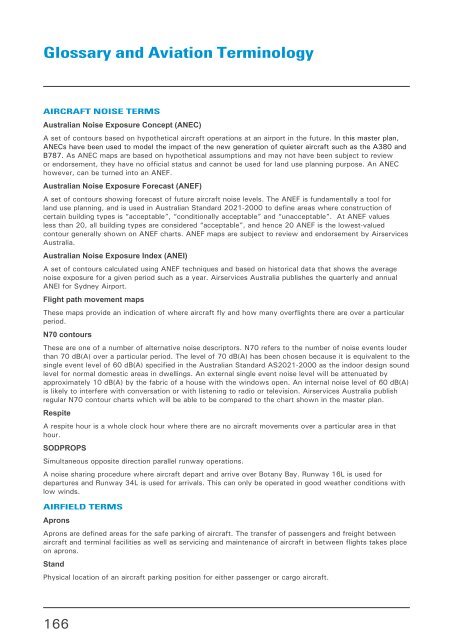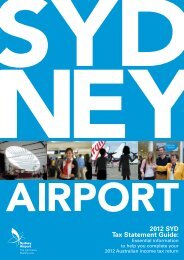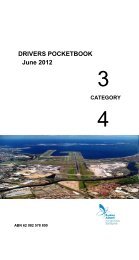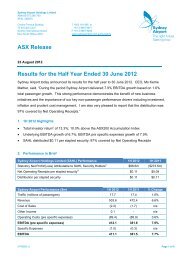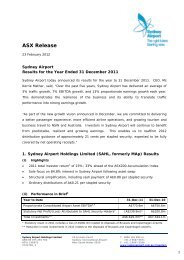Master Plan 2009 - Sydney Airport
Master Plan 2009 - Sydney Airport
Master Plan 2009 - Sydney Airport
Create successful ePaper yourself
Turn your PDF publications into a flip-book with our unique Google optimized e-Paper software.
Glossary and Aviation Terminology<br />
AIRCRAFT NOISE TERMS<br />
Australian Noise Exposure Concept (ANEC)<br />
A set of contours based on hypothetical aircraft operations at an airport in the future. In this master plan,<br />
ANECs have been used to model the impact of the new generation of quieter aircraft such as the A380 and<br />
B787. As ANEC maps are based on hypothetical assumptions and may not have been subject to review<br />
or endorsement, they have no official status and cannot be used for land use planning purpose. An ANEC<br />
however, can be turned into an ANEF.<br />
Australian Noise Exposure Forecast (ANEF)<br />
A set of contours showing forecast of future aircraft noise levels. The ANEF is fundamentally a tool for<br />
land use planning, and is used in Australian Standard 2021-2000 to define areas where construction of<br />
certain building types is “acceptable”, “conditionally acceptable” and “unacceptable”. At ANEF values<br />
less than 20, all building types are considered “acceptable”, and hence 20 ANEF is the lowest-valued<br />
contour generally shown on ANEF charts. ANEF maps are subject to review and endorsement by Airservices<br />
Australia.<br />
Australian Noise Exposure Index (ANEI)<br />
A set of contours calculated using ANEF techniques and based on historical data that shows the average<br />
noise exposure for a given period such as a year. Airservices Australia publishes the quarterly and annual<br />
ANEI for <strong>Sydney</strong> <strong>Airport</strong>.<br />
Flight path movement maps<br />
These maps provide an indication of where aircraft fly and how many overflights there are over a particular<br />
period.<br />
N70 contours<br />
These are one of a number of alternative noise descriptors. N70 refers to the number of noise events louder<br />
than 70 dB(A) over a particular period. The level of 70 dB(A) has been chosen because it is equivalent to the<br />
single event level of 60 dB(A) specified in the Australian Standard AS2021-2000 as the indoor design sound<br />
level for normal domestic areas in dwellings. An external single event noise level will be attenuated by<br />
approximately 10 dB(A) by the fabric of a house with the windows open. An internal noise level of 60 dB(A)<br />
is likely to interfere with conversation or with listening to radio or television. Airservices Australia publish<br />
regular N70 contour charts which will be able to be compared to the chart shown in the master plan.<br />
Respite<br />
A respite hour is a whole clock hour where there are no aircraft movements over a particular area in that<br />
hour.<br />
SODPROPS<br />
Simultaneous opposite direction parallel runway operations.<br />
A noise sharing procedure where aircraft depart and arrive over Botany Bay. Runway 16L is used for<br />
departures and Runway 34L is used for arrivals. This can only be operated in good weather conditions with<br />
low winds.<br />
AIRFIEld TERMS<br />
Aprons<br />
Aprons are defined areas for the safe parking of aircraft. The transfer of passengers and freight between<br />
aircraft and terminal facilities as well as servicing and maintenance of aircraft in between flights takes place<br />
on aprons.<br />
Stand<br />
Physical location of an aircraft parking position for either passenger or cargo aircraft.<br />
166


